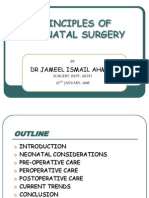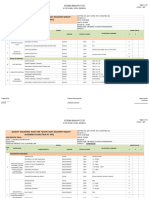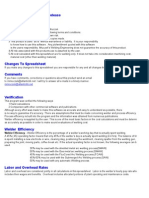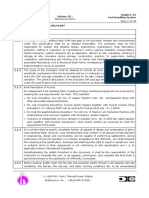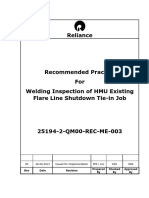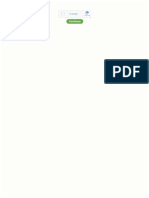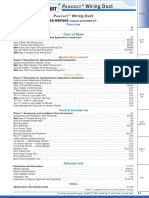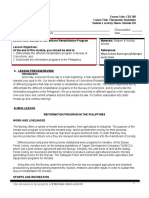Distorsion Prevented by Design
Distorsion Prevented by Design
Uploaded by
Mathew RodriguezCopyright:
Available Formats
Distorsion Prevented by Design
Distorsion Prevented by Design
Uploaded by
Mathew RodriguezOriginal Description:
Copyright
Available Formats
Share this document
Did you find this document useful?
Is this content inappropriate?
Copyright:
Available Formats
Distorsion Prevented by Design
Distorsion Prevented by Design
Uploaded by
Mathew RodriguezCopyright:
Available Formats
Distortion - prevention by
design
Strongbacks on girder flange to prevent cross bowing.
Courtesy John Allen
General guidelines are given below as 'best practice' for limiting
distortion when considering the design of arc welded structures.
Design principles
At the design stage, welding distortion can often be prevented, or at least restricted, by
considering:
elimination of welding
weld placement
reducing the volume of weld metal
reducing the number of runs
use of balanced welding
Elimination of welding
As distortion and shrinkage are an inevitable result of welding, good design requires that not
only the amount of welding is kept to a minimum, but also the smallest amount of weld metal is
deposited. Welding can often be eliminated at the design stage by forming the plate or using a
standard rolled section, as shown in ig !.
Fig. 1 Elimination of welds by: a) forming the plate b) !se
of rolled or e"tr!ded section
"f possible, the design should use intermittent welds rather
than a continuous run, to reduce the amount of welding. or
e#ample, in attaching stiffening plates, a substantial reduction
in the amount of welding can often be achieved whilst
maintaining adequate strength.
#eld placement
$lacing and balancing of welds are important in designing for minimum distortion. %he closer a
weld is positioned to the neutral a#is of a fabrication, the lower the leverage effect of the
shrinkage forces and the final distortion. &#amples of poor and good designs are shown in ig
'.
Fig. $ Distortion may be red!ced by placing the welds aro!nd the ne!tral a"is
As most welds are deposited away from the neutral a#is,
distortion can be minimised by designing the fabrication so
the shrinkage forces of an individual weld are balanced by
placing another weld on the opposite side of the neutral a#is.
Whenever possible, welding should be carried out alternately
on opposite sides, instead of completing one side first. "n
large structures, if distortion is occurring preferentially on one
side, it may be possible to take corrective actions, for
e#ample, by increasing welding on the other side to control
the overall distortion.
%ed!cing the vol!me of weld metal
%o minimise distortion, as well as for economic reasons, the volume of weld metal should be
limited to the design requirements.
or a single(sided )oint, the cross(section of the weld should be kept as small as possible to
reduce the level of angular distortion, as illustrated in ig *.
Fig. & %ed!cing the amo!nt of ang!lar distortion and lateral shrinkage by: a) red!cing
the vol!me of weld metal b) !sing single pass weld
+oint preparation angle and root gap should be minimised
providing the weld can be made satisfactorily. %o facilitate access,
it may be possible to specify a larger root gap and smaller
preparation angle. ,y cutting down the difference in the amount of
weld metal at the root and the face of the weld, the degree of
angular distortion will be correspondingly reduced. ,utt )oints made
in a single pass using deep penetration have little angular
distortion, especially if a closed butt )oint can be welded -ig *..
or e#ample, thin section material can be welded using plasma
and laser welding processes and thick section can be welded, in
the vertical position, using electrogas and electroslag processes.
Although angular distortion can be eliminated, there will still be
longitudinal and transverse shrinkage.
"n thick section material, as the cross sectional area of a double(/ )oint preparation is often only
half that of a single(/ preparation, the volume of weld metal to be deposited can be
substantially reduced. %he double(/ )oint preparation also permits balanced welding about the
middle of the )oint to eliminate angular distortion.
As weld shrinkage is proportional to the amount of weld metal, both poor )oint fit(up and over(
welding will increase the amount of distortion. Angular distortion in fillet welds is particularly
affected by over(welding. As design strength is based on throat thickness, over(welding to
produce a conve# weld bead does not increase the allowable design strength but it will increase
the shrinkage and distortion.
%ed!cing the n!mber of r!ns
%here are conflicting opinions on whether it is better to deposit a given volume of weld metal
using a small number of large weld passes or a large number of small passes. &#perience
shows that for a single(sided butt )oint, or a single(side fillet weld, a large single weld deposit
gives less angular distortion than if the weld is made with a number of small runs. Generally, in
an unrestrained )oint, the degree of angular distortion is appro#imately proportional to the
number of passes.
0ompleting the )oint with a small number of large weld deposits results in more longitudinal and
transverse shrinkage than a weld completed in a larger number of small passes. "n a multi(pass
weld, previously deposited weld metal provides restraint, so the angular distortion per pass
decreases as the weld is built up. 1arge deposits also increase the risk of elastic buckling
particularly in thin section plate.
'se of balanced welding
,alanced welding is an effective means of controlling angular distortion in a multi(pass butt weld
by arranging the welding sequence to ensure that angular distortion is continually being
corrected and not allowed to accumulate during welding. 0omparative amounts of angular
distortion from balanced welding and welding one side of the )oint first are shown schematically
in ig 2. %he balanced welding technique can also be applied to fillet )oints.
Fig. ( )alanced welding to red!ce the amo!nt of ang!lar
distortion
"f welding alternately on either side of the )oint is not possible,
or if one side has to be completed first, an asymmetrical )oint
preparation may be used with more weld metal being
deposited on the second side. %he greater contraction
resulting from depositing the weld metal on the second side
will help counteract the distortion on the first side.
)est practice
%he following design principles can control distortion:
eliminate welding by forming the plate and using rolled or e#truded sections
minimise the amount of weld metal
do not over weld
use intermittent welding in preference to a continuous weld pass
place welds about the neutral a#is
balance the welding about the middle of the )oint by using a double(/ )oint in preference
to a single(/ )oint
Adopting best practice principles can have surprising cost benefits. or e#ample, for a design
fillet leg length of 3mm, depositing an 4mm leg length will result in the deposition of 567
additional weld metal. ,esides the e#tra cost of depositing weld metal and the increase risk of
distortion, it is costly to remove this e#tra weld metal later. 8owever, designing for distortion
control may incur additional fabrication costs. or e#ample, the use of a double(/ )oint
preparation is an e#cellent way to reduce weld volume and control distortion, but e#tra costs
may be incurred in production through manipulation of the workpiece for the welder to access
the reverse side.
You might also like
- Official Guide To Employee Advocacy EbookDocument30 pagesOfficial Guide To Employee Advocacy EbookArsh AhmadNo ratings yet
- Lidar Basic Principles and ApplicationsDocument19 pagesLidar Basic Principles and Applicationskuruba saran rajNo ratings yet
- Principles of Neonatal SurgeryDocument44 pagesPrinciples of Neonatal Surgerykbmed2003100% (2)
- The Good Research Guide 4th Edition PDFDocument3 pagesThe Good Research Guide 4th Edition PDFJason0% (1)
- Brundtland ReportDocument18 pagesBrundtland ReportJoseph Santos Gacayan100% (1)
- Geoff Kulak Bolting 2007Document64 pagesGeoff Kulak Bolting 2007yrpp457jjhNo ratings yet
- New SMP For Cable Tray WorkDocument9 pagesNew SMP For Cable Tray WorkGaurav KhandelwalNo ratings yet
- PBM McnallySayajiDocument79 pagesPBM McnallySayajiBikram Dinda BikramNo ratings yet
- WHRS QapDocument31 pagesWHRS Qapmd shahabuddeenNo ratings yet
- Sludge Thickner Rev1Document22 pagesSludge Thickner Rev1epe civil1No ratings yet
- Procedure No. L&T/ Kkro / Mech / WP 05: Procedure For Ag Piping Fabrication & ErectionDocument10 pagesProcedure No. L&T/ Kkro / Mech / WP 05: Procedure For Ag Piping Fabrication & ErectiondiptiNo ratings yet
- Demo Weld Cost Calc XLDocument10 pagesDemo Weld Cost Calc XLKhalid Ahmod ShibleeNo ratings yet
- 35m GFT12A - BTS-10 - Foundation DWGDocument2 pages35m GFT12A - BTS-10 - Foundation DWGAhmad MasoodNo ratings yet
- I. Design Standard and SpecificationDocument25 pagesI. Design Standard and SpecificationChanna SannNo ratings yet
- Grating Weight - CalculationDocument1 pageGrating Weight - CalculationMuthuram NNo ratings yet
- PLC3PS8221 & 8229 Rev.01Document7 pagesPLC3PS8221 & 8229 Rev.01isan.structural TjsvgalavanNo ratings yet
- Fab Shop DrawingsDocument14 pagesFab Shop DrawingszainyousafzaiNo ratings yet
- BHEL Panki VOL III (Mechanical)Document116 pagesBHEL Panki VOL III (Mechanical)anishgirmeNo ratings yet
- Welding Inspection of Hmu Existing Flare Line Shutdown Tie-In Jobs PDFDocument5 pagesWelding Inspection of Hmu Existing Flare Line Shutdown Tie-In Jobs PDFRakesh RanjanNo ratings yet
- JOEST SouthAfrica Broschure 2016 09 WebDocument8 pagesJOEST SouthAfrica Broschure 2016 09 WebKarin AndersonNo ratings yet
- Lifting - Lug (Modification)Document11 pagesLifting - Lug (Modification)Sam LowNo ratings yet
- En8 EquDocument6 pagesEn8 EquPrapa KaranNo ratings yet
- Design Basis Report ConveyorsDocument7 pagesDesign Basis Report Conveyorsanushree4989No ratings yet
- PaintingDocument6 pagesPaintingAkhilesh KumarNo ratings yet
- Steel TableDocument41 pagesSteel Tablechirag0102No ratings yet
- Design Basis For Steel Connection of Standard Drawing - Rev Ad PDFDocument5 pagesDesign Basis For Steel Connection of Standard Drawing - Rev Ad PDFvijaystructuralNo ratings yet
- Wire RopeDocument9 pagesWire RopeMitanshu ChadhaNo ratings yet
- Experimental Effect On The Jaw Crusher PlateDocument8 pagesExperimental Effect On The Jaw Crusher PlatezsmithNo ratings yet
- Ramsey Conveyor Protection SwitchesDocument6 pagesRamsey Conveyor Protection SwitchesArif AmirNo ratings yet
- Pipe TableDocument25 pagesPipe TableMarde Vinson OpamenNo ratings yet
- New Welding Tubular Joint Used For JacketDocument6 pagesNew Welding Tubular Joint Used For JacketTien Hong DoNo ratings yet
- Single Deck Structure (Conveyor Design)Document8 pagesSingle Deck Structure (Conveyor Design)Dewi CuantikNo ratings yet
- OreFlow Australia BrochureDocument14 pagesOreFlow Australia BrochureshanhardNo ratings yet
- Development of Wear Model For Cone Crushers 2006 WearDocument8 pagesDevelopment of Wear Model For Cone Crushers 2006 WearGuilherme Linhares100% (1)
- Product Specification - Apcoshield Py905sg Grey Ral 7016 20kgDocument1 pageProduct Specification - Apcoshield Py905sg Grey Ral 7016 20kgVenkatraman Subramaniam100% (1)
- Fan Pre-Balance ChecksDocument4 pagesFan Pre-Balance ChecksMachineryengNo ratings yet
- FENN Division Tcm20-23390Document15 pagesFENN Division Tcm20-23390Juan Fernando Campuzano100% (1)
- UN 2000-07 Lifting Lugs and Lifting Trunnions 2 5: Uhde-StandardDocument1 pageUN 2000-07 Lifting Lugs and Lifting Trunnions 2 5: Uhde-StandardAndres OspinaNo ratings yet
- UNS S32760 Superduplex Stainless Steel For Wet FGD Air Pollution SystemsDocument15 pagesUNS S32760 Superduplex Stainless Steel For Wet FGD Air Pollution SystemsdsoNo ratings yet
- En 10163Document5 pagesEn 10163Kumar NawneetNo ratings yet
- Id Fan Technical SpecDocument8 pagesId Fan Technical SpecBalkishan DyavanapellyNo ratings yet
- Base Plate Design Gangway ColumnDocument2 pagesBase Plate Design Gangway ColumnsandeepNo ratings yet
- Steel Support & FoundationDocument6 pagesSteel Support & FoundationBenedict OgbaghaNo ratings yet
- Steel ColumnDocument33 pagesSteel Columnelect aksNo ratings yet
- IPSS IdlersDocument23 pagesIPSS IdlersHarish KumarNo ratings yet
- Method Statement Form: Project: MS No. Revision: 00 Date: Company: Location of Activity (Attach Sketches As Necessary)Document6 pagesMethod Statement Form: Project: MS No. Revision: 00 Date: Company: Location of Activity (Attach Sketches As Necessary)ShahdeoNo ratings yet
- Standard Specifications-Steel LayingDocument1,213 pagesStandard Specifications-Steel Layingashish.mathur1No ratings yet
- US Steel CalculatorDocument10 pagesUS Steel CalculatorKarthic KeyanNo ratings yet
- Agitator Design and SpecificationsDocument6 pagesAgitator Design and SpecificationsJesseNo ratings yet
- Shaft RequirementsDocument4 pagesShaft RequirementsMr ShrekNo ratings yet
- Rotating Equipment Installation ProcedureDocument2 pagesRotating Equipment Installation ProcedureathithancapeNo ratings yet
- Design of Bins and Hopper PDFDocument18 pagesDesign of Bins and Hopper PDFabhys_raghuNo ratings yet
- Continuous Galvanizing Line: Prashant ChoudharyDocument2 pagesContinuous Galvanizing Line: Prashant ChoudharyPrashant ChoudharyNo ratings yet
- Bolt Tightening Solutions BinderDocument18 pagesBolt Tightening Solutions BinderPranpath NarupantawartNo ratings yet
- Weld 2inchDocument4 pagesWeld 2inchGomathyselviNo ratings yet
- ALPHA700 ManualDocument50 pagesALPHA700 ManualAlexialee83No ratings yet
- WPS ExampleDocument2 pagesWPS ExampleMarcio Jr.No ratings yet
- Covered (Stick) Electrodes (SMAW)Document5 pagesCovered (Stick) Electrodes (SMAW)Hanny Dewi SaragihNo ratings yet
- Example J.7 Base Plate Bearing On Concrete: = P / (Φ · 0.85f') = Bn = B D = Φ · 0.85f' A min (2, (A / A) )Document2 pagesExample J.7 Base Plate Bearing On Concrete: = P / (Φ · 0.85f') = Bn = B D = Φ · 0.85f' A min (2, (A / A) )Martin VenichNo ratings yet
- Control Distortion During Design StageDocument5 pagesControl Distortion During Design StagebalamuruganNo ratings yet
- Lesson 5 - DistortionDocument22 pagesLesson 5 - DistortionKhepa BabaNo ratings yet
- Distortion Prevent and ControlDocument14 pagesDistortion Prevent and ControlTheAnh TranNo ratings yet
- Distortion ControlDocument6 pagesDistortion ControlMOHAMMAD ALINo ratings yet
- 17-Residual Stress and DistortionDocument20 pages17-Residual Stress and DistortionSaif UllahNo ratings yet
- Defects Lamellar TearingDocument6 pagesDefects Lamellar Tearingguru_terexNo ratings yet
- Asme Sec V 2003 For API 653 PrepDocument190 pagesAsme Sec V 2003 For API 653 PrepMathew RodriguezNo ratings yet
- (Lam) Linear&Angular Measurement GaugeDocument1 page(Lam) Linear&Angular Measurement GaugeMathew RodriguezNo ratings yet
- Distorsion Prevent by Pre Setting Pre Bending Use of RestraintDocument4 pagesDistorsion Prevent by Pre Setting Pre Bending Use of RestraintMathew RodriguezNo ratings yet
- 1169 2014-BOK Rev-071014Document9 pages1169 2014-BOK Rev-071014Siva KumarNo ratings yet
- Distorsion Corrective TechniquesDocument4 pagesDistorsion Corrective TechniquesMathew RodriguezNo ratings yet
- Fluid MechnicsDocument258 pagesFluid MechnicsMathew RodriguezNo ratings yet
- Fluid MechnicsDocument258 pagesFluid MechnicsMathew RodriguezNo ratings yet
- Fluid MechnicsDocument258 pagesFluid MechnicsMathew RodriguezNo ratings yet
- Ultrasonic Test QuestionsDocument6 pagesUltrasonic Test QuestionsMathew Rodriguez75% (4)
- Ultrasonic Test QuestionsDocument6 pagesUltrasonic Test QuestionsMathew Rodriguez75% (4)
- Fluid MechnicsDocument258 pagesFluid MechnicsMathew RodriguezNo ratings yet
- Indian AeronauticalsDocument10 pagesIndian AeronauticalsMathew RodriguezNo ratings yet
- AME ExaminationDocument154 pagesAME ExaminationMathew RodriguezNo ratings yet
- Analysis of BanyagaDocument3 pagesAnalysis of BanyagaJustine PerdiguerraNo ratings yet
- Disodium Ethylene Bis Dithio Carbamate: Material Safety Data SheetDocument7 pagesDisodium Ethylene Bis Dithio Carbamate: Material Safety Data SheetnicolNo ratings yet
- Panduit Wiring DuctDocument78 pagesPanduit Wiring DuctJason Toureiro50% (2)
- Use Full Codes For AirtelDocument2 pagesUse Full Codes For AirtelDinesh GuptaNo ratings yet
- Aoc L32H961Document83 pagesAoc L32H961Denis CamachoNo ratings yet
- RMU TenderDocument167 pagesRMU TenderbadriharishNo ratings yet
- Action Verbs For ThesisDocument6 pagesAction Verbs For Thesisbk25ghr2100% (2)
- ASFAR & CO. v. BLUNDELL AND ANOTHER. - (Document7 pagesASFAR & CO. v. BLUNDELL AND ANOTHER. - (Abel KiraboNo ratings yet
- Standard Approach To Perform Power System Stability Studies in Oil and Gas PlantsDocument13 pagesStandard Approach To Perform Power System Stability Studies in Oil and Gas PlantsShailesh ChettyNo ratings yet
- The Evolution of The Incubator Past Present and FutureDocument7 pagesThe Evolution of The Incubator Past Present and FuturearzadunpNo ratings yet
- Dbms Project IdeaDocument2 pagesDbms Project IdeaSubham RayNo ratings yet
- Dah 550w Full ScreenDocument2 pagesDah 550w Full ScreenAlessandro LacerdaNo ratings yet
- Locomotion and MovementDocument3 pagesLocomotion and MovementYouTutor PSNo ratings yet
- Model Edukasi Postnatal Melalui Pendekatan FamilyDocument19 pagesModel Edukasi Postnatal Melalui Pendekatan FamilyAgustina VivoNo ratings yet
- Physics 120 Quiz 3 Set A With Solutions and AnswersDocument4 pagesPhysics 120 Quiz 3 Set A With Solutions and Answersbatucan.almer27No ratings yet
- The Dragon MandarinDocument36 pagesThe Dragon MandarinJRS100% (2)
- New Lesson 2Document69 pagesNew Lesson 2King charles jelord Cos-agonNo ratings yet
- Article AssgnmentDocument27 pagesArticle AssgnmentNurul NadiaNo ratings yet
- SAS 10 CRI 188 Therapeutic ModalitiesDocument8 pagesSAS 10 CRI 188 Therapeutic ModalitiesKaren Angel AbaoNo ratings yet
- Theological Ethics and Political Engagement - John A. RyanDocument18 pagesTheological Ethics and Political Engagement - John A. RyanCojoc Constantin-CosminNo ratings yet
- Latian Soal Kelas X SasDocument7 pagesLatian Soal Kelas X Sasxlaa27No ratings yet
- Persian Loanwords EALLDocument5 pagesPersian Loanwords EALLLuca DötterböckNo ratings yet
- Shashika Lakmali: About MeDocument4 pagesShashika Lakmali: About MeDilusha LakmalNo ratings yet
- Header Files and Their Functions. CmathDocument19 pagesHeader Files and Their Functions. CmathSai RamNo ratings yet
- E 1489913483 PDFDocument361 pagesE 1489913483 PDFSohaib100% (1)


